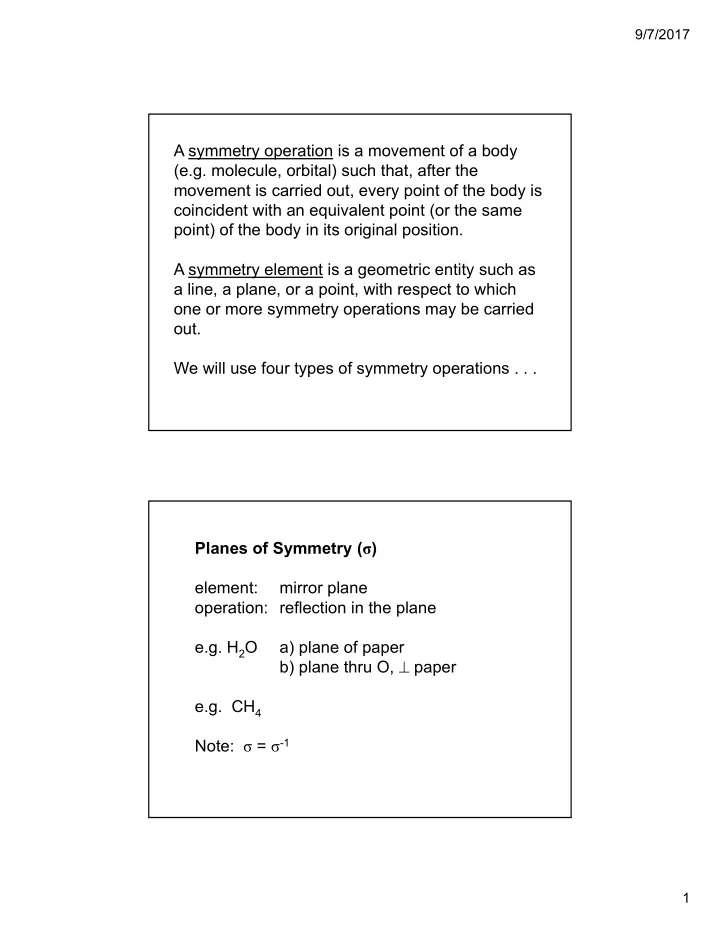

9/7/2017 A symmetry operation is a movement of a body (e.g. molecule, orbital) such that, after the movement is carried out, every point of the body is coincident with an equivalent point (or the same point) of the body in its original position. A symmetry element is a geometric entity such as a line, a plane, or a point, with respect to which one or more symmetry operations may be carried out. We will use four types of symmetry operations . . . Planes of Symmetry ( σ ) element: mirror plane operation: reflection in the plane e.g. H 2 O a) plane of paper b) plane thru O, paper e.g. CH 4 Note: σ = σ -1 1
9/7/2017 Inversion Centers (i) element: point (center of inversion) operation: inversion of all atoms through center molecules with i: N 2 , O=C=O, H-C C-H, benzene, ferrocene (staggered) molecules without i: CH 4 , BF 3 , NH 3 , ruthenocene (eclipsed) Note: i = i -1 Proper Rotations (C n m ) element: line (rotation axis) operation: one or more rotations about the axis The symmerty element is a line, about which we rotate by an angle θ , such that n θ = 2 π . ‘n’ is the order of the axis, symbol C n . convention is clockwise, looking down from top m ) -1 = C n Note: (C n n-m 2
9/7/2017 Improper Rotations (S n m ) (also called rotoreflections) element: line (rotation axis) operation: one or more rotations about the axis, followed by reflection to axis H H Consider again H H H H S 4 1,3,5,7-tetramethylcyclooctatetraene 3
9/7/2017 C 4 S 4 + 2e http://bioportal.weizmann.ac.il/course/structbioinfo/databases/ CCDC_teaching_egs/teaching_examples.3.12.html The set of all operations will constitute a group: 1. The combination of any two operations must yield another operation in the group. 2. The operation E leaves all points in their original position. E commutes with all operations. 3. Each operation has a reciprocal such that A A -1 = A -1 A = E 4. The associative law holds, i.e. for any operations A, B, and C A (B C) = (A B) C 4
9/7/2017 Point Groups: elements: operations: symbol: 1. E E C 1 2. E, σ E, σ C s 3. E, i E, i C i 4. E, C n E, C n 1 ,...,C n n-1 C n .... E, C n , nC 2 C n 7. E, C n 1 ,...,C n n-1 , n C 2 D n .... Special groups (most common) E, C , σ v 11. C v (e.g. linear A-B molecule) E, C , nC 2 C n , σ h , σ v 12. D h (e.g. linear A-A molecule) 13. tetrahedral T d 14. octrahedral O h 15. icosahedral I h Special Groups START (step 1) (a) linear molecules: Cotton’s (b) multiple high-order axes: Point Group (step 2) No proper or improper rotation Flowchart axes: C 1 , C s , C i (step 3) Only S n (n even) axis: C n axis (not a simple consequence of S 2n ) No C 2 's perpendicular to C n n C 2 's perpendicular to C n n v 's no 's h n d 's no 's h C nh C nv C n D nh D nd D n 5
9/7/2017 Table 3.1 Point groups of chiral and achiral molecules Huheey, 4e 6
9/7/2017 http://en.wikipedia.org/wiki/Meso_compound Based on Table 3.2 from HK&K Dipole moment (polar): C 1 , C s , C n , C nv No dipole moment (nonpolar): all others, i.e. those with S n ( , i, S n>2), or C n and n C 2 7
Recommend
More recommend